Despite the simple design of the switch, the range offered by manufacturers is constantly expanding. Additional functions are created and implemented that bring the comfort of using devices to a new level. To understand and choose the most suitable option, you should familiarize yourself with the main types of switches, advantages, features and differences.
- The main purpose of the switch
- Switching methods
- Screw clamping mechanism
- Spring contact mechanisms
- Breaker installation method
- Enclosure protection
- Differences between switches in control methods
- Keyboards
- Push-button devices
- Rope devices
- Rotary devices
- Sensor devices
- Acoustic
- Functionality of devices
- Popular manufacturers
The main purpose of the switch
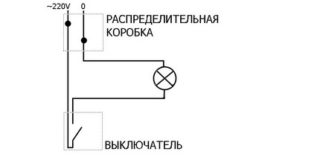
A light switch is a conductor switching device that connects and disconnects a wiring circuit. Standard models are connected to a circuit with specific parameters. The characteristics of the mechanisms and wiring must match, otherwise short circuits and other problems will arise.
The switches are designed for specific load voltage and current carrying limits. You can clarify the parameters of the device in the technical manual or look at the case. The main task of the switch is to supply power to the luminaire and stop supplying if the lighting device is not needed. Modern types of switches differ significantly from each other in many respects.
Switching methods
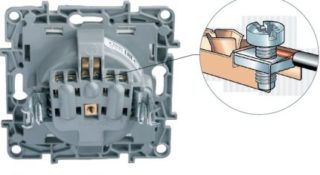
The switch connects the wires and completes the electrical circuit. There are two main methods of switching (closing and opening a circuit), each of which has its own characteristics. The final choice depends on the capabilities, skills and preferences of the installer. In particular, the price of the devices is strikingly different.
Screw clamping mechanism
An electrical switch with wire locking of this type is considered the most reliable. The clamps are secured with small screws, which are tightened until they stop. Installation requires skill and time, but the connection quality is stronger.
Electricians recommend checking the contacts and tightening them once every six months to avoid unexpected disconnection of the power circuit. The screw terminals are considered to be the most optimal for working with aluminum cables.
Spring contact mechanisms
Household electrical switches with spring terminals are the simplest in terms of the principle of operation, assembly and connection of cable ends. Inside the device, instead of screws, small plates (micro contacts) are installed, which press the wire and ensure a reliable connection to the electrical circuit.
The main disadvantage is that the end of the wire must be clamped on the correct side. Otherwise, the device will not be able to fully work. It is best to purchase mechanisms with copper contacts - the connection is more durable, the material is reliable, springy.
Breaker installation method
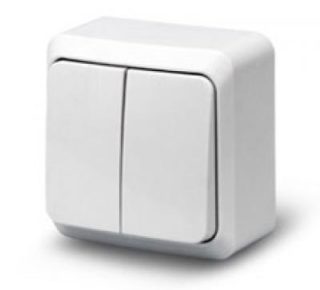
The types of switches differ in terms of installation methods: open (surface-mounted) and internal (built-in). The choice depends, first of all, on the type of wiring, the appropriate devices are selected. At the same time, it is not prohibited to install an internal switch with external wiring.
Overhead appliances protrude significantly above the surface, but do not require an additional hole inside the wall (like a socket outlet). Such devices do not always look aesthetically pleasing, but some design models are specially chosen to complement the interior and exterior decoration of the room.
For embedded switches, an additional cavity is required and must be prepared in advance. Such switches must be considered when building an initial wiring plan. The devices practically do not stand out, which makes them more aesthetic and convenient.
Enclosure protection
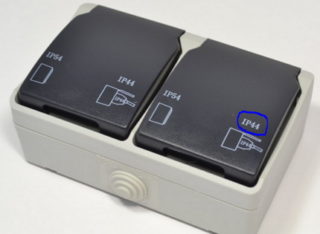
The housing should be selected in accordance with the operating conditions of the light switches and switches. Housings are manufactured with different degrees of protection. For example, for installation outdoors and in a dry room, the indicator will differ significantly. A special GOST has been developed, in accordance with which the characteristics of the production of external panels are determined.
The degree of protection of the switch can be determined by the marking. It is marked on the body with Latin letters IP and numbers. The value indicates the resistance of the device to moisture, dust and dirt. There is also a corresponding mark in the technical documents for the device.
The lowest rating is IP00, the highest rating is IP68. The first number indicates the degree of protection against dust, the second - against moisture. Devices of the first value have no protection against external conditions. The latter can work at high humidity, for example, in saunas and bathrooms, as well as outdoors.
Sometimes numbers are followed by additional letters. Symbols indicate other characteristics that are not of particular importance for domestic use. Taking into account the designations, select the appropriate device. For example, switches with IP20 ratings can be installed in a bedroom or living room of an apartment, and for a bathroom it is better to choose IP44.
Differences between switches in control methods
Modern devices are equipped with several control options. In this case, the method does not affect how the switch is arranged. The appearance and method of use are different. The choice is made based on user preferences, appearance.
Keyboards
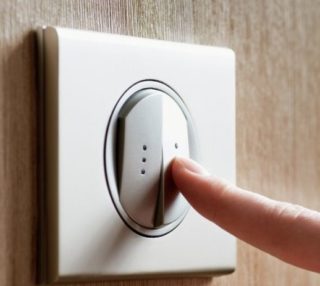
The most common and familiar option. Inside the switch, the contacts are fixed permanently, switching is carried out by a swinging mechanism on a spring, which works in compression and tension (on, off). The number of keys differs as required. The one-button switch device is considered the classic and the simplest one.
Some models use a ball that swings on a fixed rocker. The part travels along the axis and rolls, sliding the mechanism towards the contacts on the opposite side. In others, a spring-loaded frame is equipped, which, swinging, creates and breaks an electrical circuit.
The advantage of the latter is a long service life. If you choose the right device for the wiring characteristics and the conditions of use, the switch will last for several decades. The cost of key mechanisms is low, which often attracts buyers.
Push-button devices
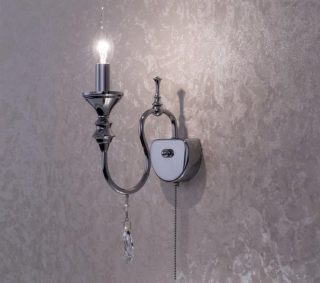
Micro contacts are connected to a spring - when first pressed, the circuit closes, when it is again disconnected. Most often found in small devices (for example, table lamps of the classic "Soviet" model). The price is not much higher than the keyboards, but it is compensated by the unusual appearance and method of switching.
Rope devices
In principle, such devices are similar to pushbutton switches. An additional detail is a lever, on one side attached to the switch button, on the other, equipped with a rope, cotton cord or chain.
The main advantages of a rope switch are that it is easier to find in the dark, even for a child. Otherwise, such devices attract only with a non-standard appearance.
Rotary devices
This type of switch is similar to keyboards in terms of the switching scheme. Inside, the contacts can only be in two positions, but a rotary lever is used as a switch. Such devices are rarely used, mainly in retro design. They can only be single, in contrast to two- and three-button switches.
Sensor devices
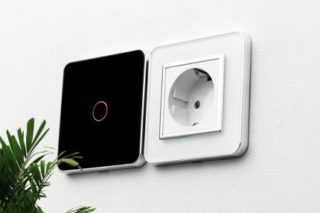
The touch switch design involves two different modes of operation. The first models worked due to the small electrical capacity of the human body (capacitor principle of operation). Upon contact, the current capacity of the device changed, which served as a signal to switch the position of the mechanism.
An additional plus of such switches is the ability to smoothly adjust the degree of illumination. When pressed quickly, it turns on / off. By keeping your finger on the surface - decrease or increase in the level of light.
The latest models look like small displays. The regulation is carried out by means of built-in microcircuits. Additional functions can be included - timer, backlight, others.
Acoustic
Switches with acoustic control have certain advantages and disadvantages. On the one hand, ease of use from anywhere in the room, on the other hand, the device can work at an unforeseen moment (the sound of a cork from champagne, clapping a child for a well-recited verse, others). Editors recommend installing them in tandem with the classic options.
Functionality of devices
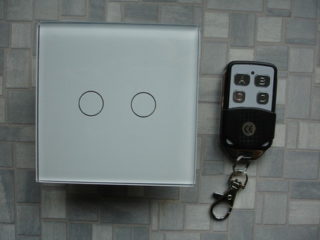
The differences between the devices in terms of functionality must be taken into account if you want to install a switch with additional functions. To find the best option, you should consider the main varieties:
- pass-through - according to the principle of operation, these are not switches, but two-position switches that close or open the required branch of the electrical circuit; work on the basis of three microcontacts, sometimes they work with a delay;
- cross / reversible - designed to control one light source from three or more points; for example, you can turn on the light in the corridor on the first floor, and turn it off on the last, often used in bedrooms - one next to the door, the other near the bed;
- light controls (dimmers) - allow you to smoothly change the illumination in the room;
- remote - supplemented with special consoles, one of the developments of the "smart home" system.
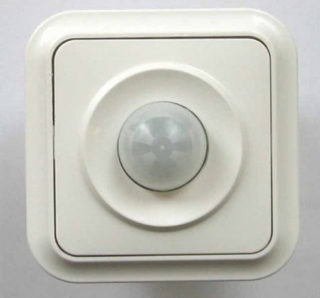
Modern switches and switches can include several different functions at the same time. The most common are:
- backlight - allows you to quickly find the device in the dark, can serve as a kind of reference point when moving around the room;
- controllers - used if the lighting device is located in one room, and the switch is in another, on the body, simultaneously with the light bulb, a small diode turns on and off;
- timer - automatic interruption of the circuit after a specified period of time, after which the light goes out;
- motion sensor - reacts to movement in the room, allows you to save energy - will not "forget" to turn off if there is no one in the room;
- The presence sensor is a relatively new development, it controls with the help of infrared radiation, which "checks" the presence of a person in the room - the light will not turn off, even if it is kept in one position for a long time.
Depending on the floor plan, user preferences, the best option is selected. Manufacturers are constantly making amendments, creating new interesting models.
Popular manufacturers
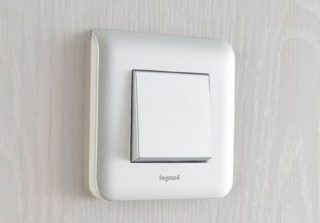
Many parameters depend on the manufacturer of switches, like other products: quality of work, service life, appearance, state of elements, and other characteristics. Companies that have been working for a long time and constantly maintain the level of customer interest are more responsible in the production of products.
The French company Legrand is one of the five largest electrical manufacturers in Europe. The direction of work is development and improvement. In some countries it is sold under other names - Contactor, BTicino, Sarlam, others. The list of models is diverse, with each product going through several stages of verification, which guarantees quality and reliability. A distinctive feature of each brand product is a self-extinguishing plastic case (important for high-voltage networks).
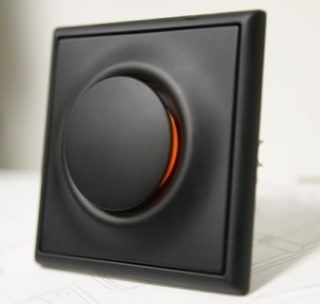
The Swedish company ABB is one of the world leaders in the production of electrical components in the world. The predominant direction is modular products, from which sets can be assembled in any order. The enclosures are made of impact-resistant, UV-resistant materials.
Among Russian manufacturers, the Kuntsevo-Electro factory occupies a special place. The company has been operating for over 30 years. Product design is laconic. Switches and sockets of the brand are distinguished by a long service life, low cost.
Classic one-, two-button switches are just one of the device options. Modern switches combine several functions, differ in non-standard solutions and design. Users give preference to new developments that can improve the comfort of use and solve some issues. To find the right option, take into account the parameters of the network, premises, then personal preferences.








